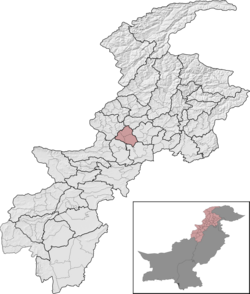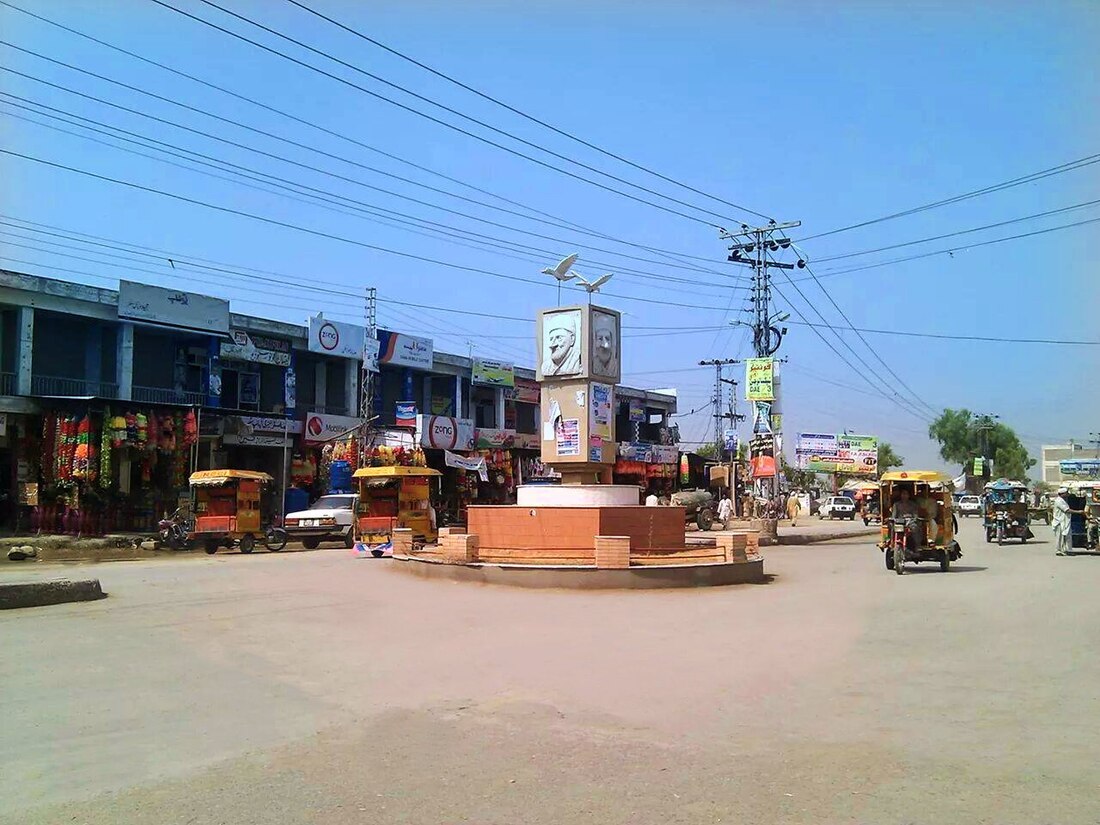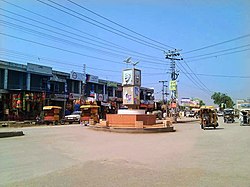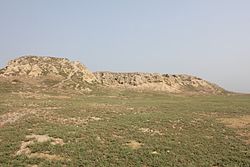Charsadda District, Pakistan
District of Khyber Pakhtunkhwa in Pakistan From Wikipedia, the free encyclopedia
Charsadda District (Pashto: چارسدې ولسوالۍ, Urdu: ضلع چارسدہ) is a district in the Peshawar Division of the Khyber Pakhtunkhwa province of Pakistan. Prior to its establishment as a separate district in 1998, it was a tehsil within the Peshawar District.[3] Mohamedzai Pashtuns make up the majority of the population of the district along with other minor tribes settled as well such as Uthmankhel, Mohmand, Kakakhel, Khattak. The district headquarter is the town of Charsadda, which was once part of the Peshawar ex-metropolitan region.
Charsadda District
ضلع چارسدہ چارسدې ولسوالۍ | |
|---|---|
 Charsadda District (red) in Khyber Pakhtunkhwa | |
| Country | Pakistan |
| Province | Khyber Pakhtunkhwa |
| Division | Peshawar |
| Headquarters | Charsadda |
| Government | |
| • Type | District Administration |
| • Deputy Commissioner | Saad Hussain |
| • District Police Officer | N/A |
| • District Health Officer | N/A |
| Area | |
• Total | 996 km2 (385 sq mi) |
| Population | |
• Total | 1,835,504 |
| • Density | 1,800/km2 (4,800/sq mi) |
| • Urban | 292,396 (15.93%) |
| • Rural | 1,543,108 |
| Literacy | |
| • Literacy rate | { bulleted list| Total: 53.94% | Male: 66.55% | Female: 40.36% }} |
| Time zone | UTC+5 (PST) |
| Number of Tehsils | 3 |
| Website | charsadda |
Overview and history
Summarize
Perspective
The district lies between 34-03' and 34-38' north latitudes and 71-28' and 71-53' east longitudes. Charsadda is located in the west of the Khyber Pakhtunkhwa and is bounded by the Malakand District to the north, Mardan district to the east, Nowshera and Peshawar districts to the south and Mohmand district to the west. The district covers an area of 996 square kilometers.
Charsadda was once part of the kingdom of Gandhara. However, around 516 BC Gandhara became part of the seventh satrapy or province of the Achaemenid Empire and paid tribute to Darius the Great of Persia, until it was overthrown by Alexander the Great in the 4th century BC.
After the death of Alexander in 323 BC, the Indian Emperor Chandragupta Maurya rose to power and brought Gandhara under his sway. According to a popular tradition, Emperor Ashoka built one of his stupas there.[citation needed] Actually, there were two stupas built by Ashoka, mentioned by the famous Chinese Buddhist pilgrim Hieun Tsang, who visited it in 630 AD. Both were near the town of Po-Lu-Sha, one was outside the eastern gate of the town, and the other 20 li (10 km) northeast of it, on the mount Dantaloka.[4]
To the east, a Brahminical temple stood while to the north, a monastery was located. According to Buddhists, this monastery was the place where Buddha preached the Law. The name Gandhara went out of usage after Mahmud of Ghazni conquered the area and converted it to Islam in 1026.[citation needed]
Bactrian Greeks
This area was also ruled by the Bactrian Greeks between 250–125 BC which was succeeded by the Indo-Greek Kingdom who ruled until 10 AD.
Shabqadar
Shabqadar is a tehsil within the District Charsadda. It is 17 miles (27 km) north west of Peshawar. A fort was built here by the Sikhs called Sharkargarh. The town was burnt by the Mohmands in 1897. It has since been rebuilt.[citation needed]
Bibi Syeda Dheri
Bibi Syeda Dheri is a site half a mile to the north of Umarzai village in Charsadda tehsil. At this location, a mound rises to a height of 60 ft (18 m). It is believed to be the site of the stupa erected to commemorate the conversion by Buddha of goddess Hariti who used to devour children of the locality. There is also a shrine of a lady saint Bibi Syeda.[citation needed]
Shar-i-Napursan
Shar-i-Napursan is an archaeological site in Charsadda tehsil near the village Rajjar. Excavations have unearthed two distinct settlements of the Buddhist period and two of the Muslim period. Coins of Menander, Hermaeus and Kanishka have been unearthed.[5]
Palatu Dheri

Palatu Dheri is another archaeological site near Charsadda tehsil. A mile from Shar-i-Napursan is a mound which contains the remains of a stupa, which according to Hieun Tsiang, was built by one Deven. Some coins which connect them both to the first century AD have been unearthed. Other finds include the image of the goddess Kalika-devi. Three inscribed jars, which were presented by some laymen to "the Community of the Four Quarters", are now in the Peshawar Museum.[citation needed]
Charsadda
The city of Charsadda originally known as Pushkalavati is mentioned in the Hindu epic story the Ramayana, where Bharata brings this new conquered city to one of his sons, Pushkala.[7]
Bala Hisar of Charsadda
Bala Hisar was excavated twice by the head of the Archaeological Survey of India, Sir John Marshall, in 1902 and by Sir Mortimer Wheeler in 1958. According to the South Asian Archaeology Research Group of Bradford University, Wheeler suggested that Bala Hisar "was founded by the Persians in the sixth century BC as a colony guarding the eastern edge of their empire".[8]
Demographics
Summarize
Perspective
| Year | Pop. | ±% p.a. |
|---|---|---|
| 1951 | 282,618 | — |
| 1961 | 364,088 | +2.57% |
| 1972 | 513,193 | +3.17% |
| 1981 | 630,811 | +2.32% |
| 1998 | 1,022,364 | +2.88% |
| 2017 | 1,610,960 | +2.42% |
| 2023 | 1,835,504 | +2.20% |
| Sources:[9] | ||
As of the 2023 census, Charsadda district has 263,934 households and a population of 1,835,504. The district has a sex ratio of 107.49 males to 100 females and a literacy rate of 53.94%: 66.55% for males and 40.36% for females. 542,879 (29.58% of the surveyed population) are under 10 years of age. 292,426 (15.93%) live in urban areas.[1] Pashto is the predominant language, spoken by 99.66% of the population.[10]
| Religion | 1941[11][a] | 2017[12] | 2023[13] | |||
|---|---|---|---|---|---|---|
| Pop. | % | Pop. | % | Pop. | % | |
| Islam |
239,634 | 98.11% | 1610087 | 99.95% | 1,830,646 | 99.76% |
| Hinduism |
2,533 | 1.04% | 38 | ~0% | 41 | ~0% |
| Sikhism |
1,940 | 0.79% | — | — | 14 | ~0% |
| Christianity |
127 | 0.05% | 518 | 0.03% | 4,392 | 0.24% |
| Others | 12 | 0.01% | 317 | 0.02% | 43 | ~0% |
| Total Population | 244,246 | 100% | 1610960 | 100% | 1,835,136[b] | 100% |
Administration
Summarize
Perspective
The district is administratively subdivided into 3 Tehsils comprising a total of 58 Union Councils:[14]
| Tehsil | Urdu Name | Pashto Name | No. of Union Councils |
|---|---|---|---|
| Charsadda | تحصیل چارسدہ | چارسدې تحصیل | 34 |
| Tangi | تحصیل تنگی | تنګي تحصیل | 12 |
| Shabqadar | تحصیل شب قدر | شب قدر تحصیل | 12 |
National Assembly Seats
The district is represented in the National Assembly by two MNAs who represent the following constituencies:[15]
| Constituency | MNA | Party |
|---|---|---|
| NA-24 (Charsadda-I) | Malik Anwar Taj | SIC |
| NA-25 (Charsadda-II) | Mr. Fazal Muhammad Khan | SIC |
Provincial Assembly Seats
The district is represented in the Provincial Assembly by five MPAs who represent the following constituencies:[16]
Towns and villages
- Sardheri
- Sukar
- Matta Mughal Khel
- Ambhader
- Daulat Pura
- Kangra
See also
References
Bibliography
Wikiwand - on
Seamless Wikipedia browsing. On steroids.


